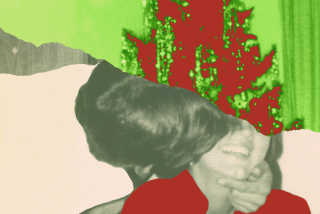Nourishing a Family Tree After One of Its Leaves Has Fallen
It’s terrible when a man of action finds himself in a situation that seems to offer no recourse except philosophy.
Joe Amado came face-to-face with such a dilemma four years ago. His brother Mario, 29 and Joe’s junior by two decades, had been killed in 1992 by Tijuana police during a vacation the brothers had taken with their girlfriends. The police had claimed the death a suicide.
Not knowing what else to do, Amado and his sister and mother picketed the border, demanding justice. For 31/2 years, he hectored the Mexican government, eventually harnessing the forces of the FBI, a U.S. congressman and American network television.
Finally, a Tijuana policeman was convicted. It was a stunning victory, even though the cop was released by a judge after three years in jail.
The case effectively closed, Joe Amado was left with his abiding grief, guilt and anger. To understand how he responded, you have to understand Joe Amado, and there are easier things in the world to do.
He grew up in the small migrant worker camp his father ran in Corcoran. Today, behind his worn one-story house in Shadow Hills in the northern San Fernando Valley, a dusty corral of a backyard encloses a small flock of geese, four white peacocks, a fat Vietnamese potbellied pig, a couple of rabbits, an emu named Elmo and a fiery rooster that tries to copulate with a small pillow every time Amado, for a laugh, tosses it near him. At the edge of his property, Amado has built a replica of an Old West saloon, his hideaway and hatching place for schemes.
Both a naif and an operator, Amado believes the world is knowable and that he can function effectively in any part of it. It helps that he is a stranger to embarrassment.
What to do after Mario’s case was closed? The answer came to Joe Amado after a family reunion in Tubac, Ariz., in mid-1997. He’d gone there to distribute a video on Mario’s case and had been astonished by what he learned of his family’s history.
The Amados had been pioneers in southwestern Arizona. A distant uncle, Merejildo Grijalva, had been a renowned U.S. Army scout who served as translator at the Gadsden Purchase, which brought southern Arizona into the United States in 1853. The Arizona town of Amado had been founded by another distant uncle. A branch of the family was among Tucson’s civic elite.
All of this struck Amado with the force of biblical revelation. He resolved to create a monument that would subsume the unresolvable loss of Mario in a pageant of forebears and in United States history itself. This he would place somewhere near the epicenter of the Amados’ early years in America.
No matter that Mario had been an unachieving young man, a high school dropout fond of beer and shy of work. No matter that Mario had never set foot in Arizona. No matter that others wondered what place he had among figures of demonstrable significance.
Joe Amado got to work.
He lined up a neighbor in the marble business to donate a slab of black granite. He importuned an artist friend to draw figures for the monument. He got an acquaintance to work out the lettering on a computer.
There were setbacks: The local historical society in Arizona declined to harbor the monument. A prominent member of the Tucson Amados was so appalled by his plans that she put a lawyer on the case. The artist fell ill. Amado and the marble man had a falling out. The computer specialist faded away.
All these Joe Amado shrugged off. He’d known worse while bringing Mexico to heel.
He would do the artwork himself. Laboring till dawn in his makeshift saloon, he sketched and lettered, pausing to drink beer, to leak tears and to scrawl, for posterity, his galloping thoughts on the backs of old press releases about Mario’s case.
It took him a year and a half. A life-size drawing of the monument now hangs in the saloon, waiting to be committed to granite. It depicts not only luminaries from Amado family history but Geronimo and Cochise. There’s a drawing of Mario over a United States flag and the inscription “God Bless America.” Next to that is a drawing of Joe himself (“Joe Amado ‘Artist,’ ” the words below proclaim).
The Amado Territory Inn in Amado, Ariz., has consented to place the monument on its grounds. Now all Joe has to do is raise the five or six thousand he thinks it will take to buy the granite, engrave it with his drawing and take it to Arizona.
“This is going to happen,” he insists. “I make things happen, you know? I mean, this is something you can’t erase once it’s done. I mean, this is going to be on stone.”
Thus does Joe Amado propose to hold off oblivion--by dint of will and productive effort. Sooner or later (maybe much, much later) his dream is bound to prove futile, but that doesn’t mean there isn’t something heroic in it. How can anyone not wish him luck?
More to Read
Sign up for Essential California
The most important California stories and recommendations in your inbox every morning.
You may occasionally receive promotional content from the Los Angeles Times.










